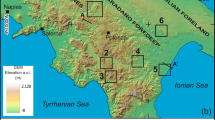Abstract
We present an approach to perform geomorphometric analysis for Digital Elevation Models (DEM) to obtain the Cartographic Knowledge Domain (CKD) of the landscapes. CKD is oriented to represent the essential properties of DEM by means of concepts. These properties are obtained by analyzing the terrain topography. This analysis is based on two classifications: landform and topographic ruggedness. The approach involves the following raster layers: slope, profile curvature and plan curvature (primary attributes), which have been built to identify the intrinsic properties of the landscape. We use a multi-valued raster to integrate the primary attributes of DEM to generate the landform classification layer in order to find the terrain characteristics of the water movement. The topographic ruggedness is used to express the amount of elevation difference between adjacent cells of DEM. The topographic ruggedness is presented by means of Terrain Ruggedness Index (TRI). This work is oriented to support subsequent processes. The method has been implemented into Geographical Information System – ArcInfo, and applied for Tamaulipas State, Mexico.
Preview
Unable to display preview. Download preview PDF.
Similar content being viewed by others
References
Moreno, M., Levachkine, S., Torres, M., Quintero, R.: Landform Classification in Raster Geo-Images. In: Sanfeliu, A., Martínez Trinidad, J.F., Carrasco Ochoa, J.A. (eds.) CIARP 2004. LNCS, vol. 3287, pp. 558–565. Springer, Heidelberg (2004)
Wilson, J.P., Gallant, J.C.: Terrain Analysis- Principles and Applications. John Willey & Sons, USA (2000)
Pennock, D.J., Zebarth, B.J., de Jong, E.: Landform classification and soil distribution in hummocky terrain. Sasketchewan, Canada, Geoderma. 40, 297–315 (1997) Bonk, R: Scale-dependent Geomorphometric Analysis for Glacier Mapping at Nanga Parbat
Torres, M., Levachkine, S.: Semantics Definition to Represent Spatial Data. In: Levachkine, S., Ruas, A., Bodansky, E. (eds.) Proc. International Workshop on Semantic Processing of Spatial Data (GEOPRO 2002), Mexico City, Mexico, December 3-4 (2002)
Torres, M., Moreno, M., Menchaca, R., Levachkine, S.: Making Spatial Analysis with a Distributed Geographical Information System. In: International Conference on Databases and Applications (DBA 2003), IASTED, pp. 1245–1256 (2003)
Molenaar, M.: An Introduction to the theory of spatial object modelling for GIS. Taylor & Francis, U.K (1998)
Burrough, P.A.: Principles of Geographical Information Systems for Land Resources Assessment. Oxford University Press, New York (1986)
Riley, S.J., DeGloria, S.D., Elliot, R.: A terrain ruggedness index that quantifies topographic heterogeneity. Intermountain Journal of Sciences 5, 23–27 (1999)
Author information
Authors and Affiliations
Editor information
Editors and Affiliations
Rights and permissions
Copyright information
© 2005 Springer-Verlag Berlin Heidelberg
About this paper
Cite this paper
Moreno, M., Levachkine, S., Torres, M., Quintero, R., Guzman, G. (2005). Automatic Geomorphometric Analysis for Digital Elevation Models. In: Khosla, R., Howlett, R.J., Jain, L.C. (eds) Knowledge-Based Intelligent Information and Engineering Systems. KES 2005. Lecture Notes in Computer Science(), vol 3684. Springer, Berlin, Heidelberg. https://doi.org/10.1007/11554028_52
Download citation
DOI: https://doi.org/10.1007/11554028_52
Publisher Name: Springer, Berlin, Heidelberg
Print ISBN: 978-3-540-28897-8
Online ISBN: 978-3-540-31997-9
eBook Packages: Computer ScienceComputer Science (R0)




